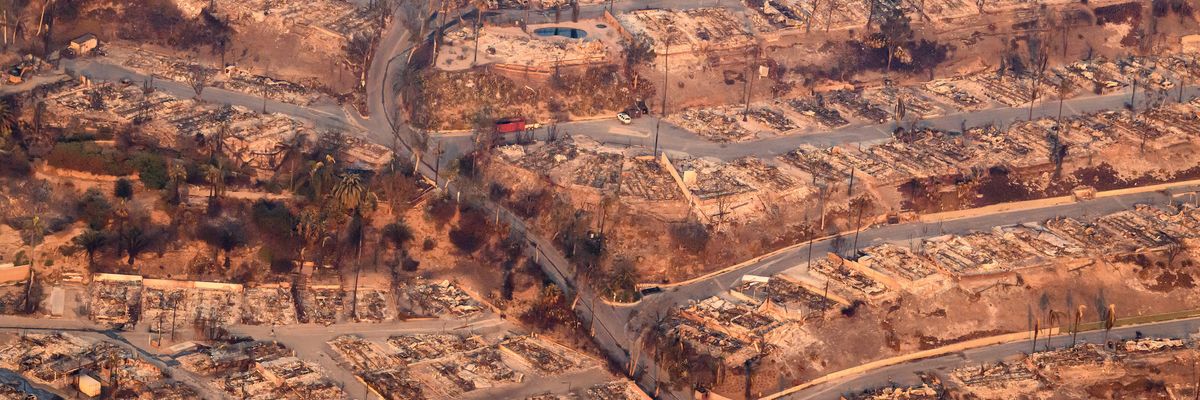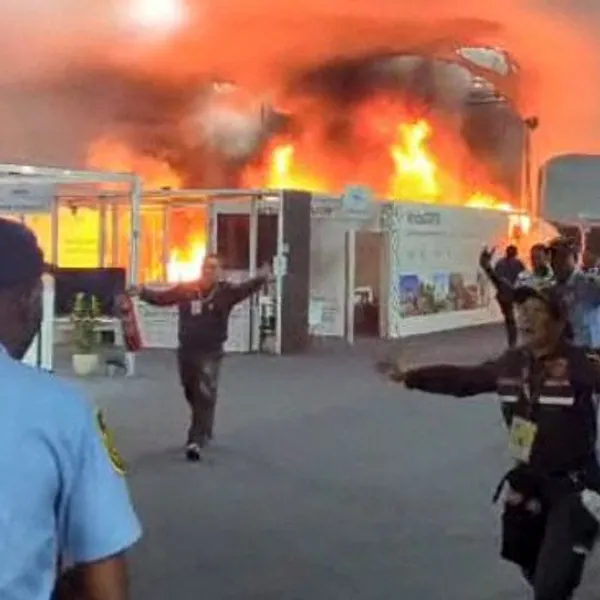
The LA Fires Show the Price of Climate Inaction
Measures like controlled burns, increased funding for fire departments, and more thoughtful residential planning can help California going forward, but it will take more to slash emissions and address the climate emergency.
If you grew up in Southern California, you don’t need a weather person to know which way the Santa Ana winds blow.
These dry winds originate in the Great Basin and sweep down the mountains toward the Southern California coast. They lower the humidity and raise the temperature, creating critical fire weather conditions. “The wind shows us how close to the edge we are,” Joan Didion once observed in her essay “Los Angeles Notebook.”
The Santa Anas typically occur during the fall. But more and more often, they’re happening this time of year. In tandem, the changing climate is making Southern California drier.
Disturbingly, President-elect Donald Trump, a climate change denier, intends to gut even the inadequate measures that the U.S. has already taken.
This January, ferocious gusts up to 100 miles per hour overlapped with a months-long drought to create the conditions for the apocalyptic infernos now devastating Greater Los Angeles. The Eaton and Palisades fires—among the most destructive in California history—have together consumed over 37,000 acres. Losses could top $100 billion, according to AccuWeather.
Seeing the Eaton fire’s menacing flames from my family’s San Gabriel Valley home, driving past thick smoke and fallen palm fronds on the freeway, and receiving a mistaken evacuation alert showed me what “close to the edge” can look like. While we’ve been spared for now, many others have lost their homes, livelihoods, and a part of their families’ history.
The fires have forced tens of thousands to evacuate their homes, destroyed over 12,300 structures, and killed at least 25 people. Some victims died while trying to protect their homes, like Victor Shaw, 66, found outside his Altadena house clutching a garden hose.
The fires have ravaged lower-income communities, historic Black neighborhoods in Altadena, and cultural landmarks like actor Will Rogers’ historic ranch house in the Pacific Palisades. Mass displacement is exacerbating the housing crisis in Los Angeles County, where roughly 75,000 unhoused people are now directly exposed to toxic smoke. Wildlife and pets haven’t been spared either.
The climate emergency has worsened this destruction. As the fires burned, scientists confirmed that 2024 was the world’s warmest year on record. Dramatic swings between intensely wet and dry weather—described by climate scientist Daniel Swain as “hydroclimate whiplash”—are increasing worldwide, resulting in more dangerous floods along with droughts that amplify wildfire risks.
Average global temperatures have now exceeded the Paris agreement threshold of 1.5°C (2.7°F) above preindustrial levels. To avoid further catastrophe, fossil fuel emissions must be slashed by 43% by 2030 and reach “net zero” by 2050, according to the United Nations.
Disturbingly, President-elect Donald Trump, a climate change denier, intends to gut even the inadequate measures that the U.S. has already taken. He’s widely expected to withdraw our nation—the biggest historical emitter of carbon dioxide—from the Paris agreement, as he did during his first administration, and he’s said he intends to cancel President Joe Biden’s historic investments in green jobs.
The result of these actions will be more heat and extreme weather.
Communities across the Southeast are still reeling from Hurricanes Helene and Milton in September and October, which killed over 250 people and caused over $100 billion in damages. Warmer ocean temperatures are supercharging these and other storms.
Measures like controlled burns, increased funding for fire departments, and more thoughtful residential planning in wildfire-prone areas can help California going forward, but it will take more to slash emissions and address the climate emergency.
Fossil fuel companies should be held accountable as well. The state of California is currently suing them for deceiving the public for decades about their products’ central role in the climate crisis and demanding that they pay for billions of dollars in damages. These latest fires should be added to the list.
Amid Angelenos banding together and vowing to rebuild what they’ve lost, the fires are yet another tragic reminder of how people and our planet pay the ultimate price for climate inaction.
An Urgent Message From Our Co-Founder
Dear Common Dreams reader, The U.S. is on a fast track to authoritarianism like nothing I've ever seen. Meanwhile, corporate news outlets are utterly capitulating to Trump, twisting their coverage to avoid drawing his ire while lining up to stuff cash in his pockets. That's why I believe that Common Dreams is doing the best and most consequential reporting that we've ever done. Our small but mighty team is a progressive reporting powerhouse, covering the news every day that the corporate media never will. Our mission has always been simple: To inform. To inspire. And to ignite change for the common good. Now here's the key piece that I want all our readers to understand: None of this would be possible without your financial support. That's not just some fundraising cliche. It's the absolute and literal truth. We don't accept corporate advertising and never will. We don't have a paywall because we don't think people should be blocked from critical news based on their ability to pay. Everything we do is funded by the donations of readers like you. Will you donate now to help power the nonprofit, independent reporting of Common Dreams? Thank you for being a vital member of our community. Together, we can keep independent journalism alive when it’s needed most. - Craig Brown, Co-founder |
If you grew up in Southern California, you don’t need a weather person to know which way the Santa Ana winds blow.
These dry winds originate in the Great Basin and sweep down the mountains toward the Southern California coast. They lower the humidity and raise the temperature, creating critical fire weather conditions. “The wind shows us how close to the edge we are,” Joan Didion once observed in her essay “Los Angeles Notebook.”
The Santa Anas typically occur during the fall. But more and more often, they’re happening this time of year. In tandem, the changing climate is making Southern California drier.
Disturbingly, President-elect Donald Trump, a climate change denier, intends to gut even the inadequate measures that the U.S. has already taken.
This January, ferocious gusts up to 100 miles per hour overlapped with a months-long drought to create the conditions for the apocalyptic infernos now devastating Greater Los Angeles. The Eaton and Palisades fires—among the most destructive in California history—have together consumed over 37,000 acres. Losses could top $100 billion, according to AccuWeather.
Seeing the Eaton fire’s menacing flames from my family’s San Gabriel Valley home, driving past thick smoke and fallen palm fronds on the freeway, and receiving a mistaken evacuation alert showed me what “close to the edge” can look like. While we’ve been spared for now, many others have lost their homes, livelihoods, and a part of their families’ history.
The fires have forced tens of thousands to evacuate their homes, destroyed over 12,300 structures, and killed at least 25 people. Some victims died while trying to protect their homes, like Victor Shaw, 66, found outside his Altadena house clutching a garden hose.
The fires have ravaged lower-income communities, historic Black neighborhoods in Altadena, and cultural landmarks like actor Will Rogers’ historic ranch house in the Pacific Palisades. Mass displacement is exacerbating the housing crisis in Los Angeles County, where roughly 75,000 unhoused people are now directly exposed to toxic smoke. Wildlife and pets haven’t been spared either.
The climate emergency has worsened this destruction. As the fires burned, scientists confirmed that 2024 was the world’s warmest year on record. Dramatic swings between intensely wet and dry weather—described by climate scientist Daniel Swain as “hydroclimate whiplash”—are increasing worldwide, resulting in more dangerous floods along with droughts that amplify wildfire risks.
Average global temperatures have now exceeded the Paris agreement threshold of 1.5°C (2.7°F) above preindustrial levels. To avoid further catastrophe, fossil fuel emissions must be slashed by 43% by 2030 and reach “net zero” by 2050, according to the United Nations.
Disturbingly, President-elect Donald Trump, a climate change denier, intends to gut even the inadequate measures that the U.S. has already taken. He’s widely expected to withdraw our nation—the biggest historical emitter of carbon dioxide—from the Paris agreement, as he did during his first administration, and he’s said he intends to cancel President Joe Biden’s historic investments in green jobs.
The result of these actions will be more heat and extreme weather.
Communities across the Southeast are still reeling from Hurricanes Helene and Milton in September and October, which killed over 250 people and caused over $100 billion in damages. Warmer ocean temperatures are supercharging these and other storms.
Measures like controlled burns, increased funding for fire departments, and more thoughtful residential planning in wildfire-prone areas can help California going forward, but it will take more to slash emissions and address the climate emergency.
Fossil fuel companies should be held accountable as well. The state of California is currently suing them for deceiving the public for decades about their products’ central role in the climate crisis and demanding that they pay for billions of dollars in damages. These latest fires should be added to the list.
Amid Angelenos banding together and vowing to rebuild what they’ve lost, the fires are yet another tragic reminder of how people and our planet pay the ultimate price for climate inaction.
- EU Crisis Official Warns of 'Climate Breakdown' Amid Deadly Wildfires and Flooding ›
- US Faced 27 Billion-Dollar Disasters in 2024, the Hottest Year on Record ›
- Critics Say Biden's Climate Inaction Belies Lofty Claims in UN Speech ›
- Ticker Shows Climate Inaction Cost US Nearly $3,000 Per Second in 2023 ›
If you grew up in Southern California, you don’t need a weather person to know which way the Santa Ana winds blow.
These dry winds originate in the Great Basin and sweep down the mountains toward the Southern California coast. They lower the humidity and raise the temperature, creating critical fire weather conditions. “The wind shows us how close to the edge we are,” Joan Didion once observed in her essay “Los Angeles Notebook.”
The Santa Anas typically occur during the fall. But more and more often, they’re happening this time of year. In tandem, the changing climate is making Southern California drier.
Disturbingly, President-elect Donald Trump, a climate change denier, intends to gut even the inadequate measures that the U.S. has already taken.
This January, ferocious gusts up to 100 miles per hour overlapped with a months-long drought to create the conditions for the apocalyptic infernos now devastating Greater Los Angeles. The Eaton and Palisades fires—among the most destructive in California history—have together consumed over 37,000 acres. Losses could top $100 billion, according to AccuWeather.
Seeing the Eaton fire’s menacing flames from my family’s San Gabriel Valley home, driving past thick smoke and fallen palm fronds on the freeway, and receiving a mistaken evacuation alert showed me what “close to the edge” can look like. While we’ve been spared for now, many others have lost their homes, livelihoods, and a part of their families’ history.
The fires have forced tens of thousands to evacuate their homes, destroyed over 12,300 structures, and killed at least 25 people. Some victims died while trying to protect their homes, like Victor Shaw, 66, found outside his Altadena house clutching a garden hose.
The fires have ravaged lower-income communities, historic Black neighborhoods in Altadena, and cultural landmarks like actor Will Rogers’ historic ranch house in the Pacific Palisades. Mass displacement is exacerbating the housing crisis in Los Angeles County, where roughly 75,000 unhoused people are now directly exposed to toxic smoke. Wildlife and pets haven’t been spared either.
The climate emergency has worsened this destruction. As the fires burned, scientists confirmed that 2024 was the world’s warmest year on record. Dramatic swings between intensely wet and dry weather—described by climate scientist Daniel Swain as “hydroclimate whiplash”—are increasing worldwide, resulting in more dangerous floods along with droughts that amplify wildfire risks.
Average global temperatures have now exceeded the Paris agreement threshold of 1.5°C (2.7°F) above preindustrial levels. To avoid further catastrophe, fossil fuel emissions must be slashed by 43% by 2030 and reach “net zero” by 2050, according to the United Nations.
Disturbingly, President-elect Donald Trump, a climate change denier, intends to gut even the inadequate measures that the U.S. has already taken. He’s widely expected to withdraw our nation—the biggest historical emitter of carbon dioxide—from the Paris agreement, as he did during his first administration, and he’s said he intends to cancel President Joe Biden’s historic investments in green jobs.
The result of these actions will be more heat and extreme weather.
Communities across the Southeast are still reeling from Hurricanes Helene and Milton in September and October, which killed over 250 people and caused over $100 billion in damages. Warmer ocean temperatures are supercharging these and other storms.
Measures like controlled burns, increased funding for fire departments, and more thoughtful residential planning in wildfire-prone areas can help California going forward, but it will take more to slash emissions and address the climate emergency.
Fossil fuel companies should be held accountable as well. The state of California is currently suing them for deceiving the public for decades about their products’ central role in the climate crisis and demanding that they pay for billions of dollars in damages. These latest fires should be added to the list.
Amid Angelenos banding together and vowing to rebuild what they’ve lost, the fires are yet another tragic reminder of how people and our planet pay the ultimate price for climate inaction.
- EU Crisis Official Warns of 'Climate Breakdown' Amid Deadly Wildfires and Flooding ›
- US Faced 27 Billion-Dollar Disasters in 2024, the Hottest Year on Record ›
- Critics Say Biden's Climate Inaction Belies Lofty Claims in UN Speech ›
- Ticker Shows Climate Inaction Cost US Nearly $3,000 Per Second in 2023 ›

